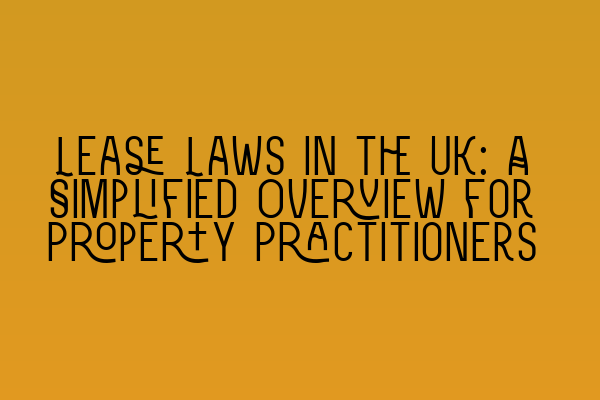Lease Laws in the UK: A Simplified Overview for Property Practitioners
As a property practitioner in the UK, understanding lease laws is essential. Whether you are a solicitor, conveyancer, or property lawyer, having a comprehensive understanding of lease laws will help you navigate various legal obligations and protect your clients’ interests. In this blog post, we will provide a simplified overview of lease laws in the UK, covering key concepts and important considerations.
What is a Lease?
A lease is a legally binding contract between a landlord (lessor) and a tenant (lessee) that grants the tenant the right to occupy and use a property for a specified period of time. It establishes the terms and conditions under which the tenant may possess and enjoy the property.
Leases can be for different types of properties, including residential, commercial, and agricultural properties. Each type of lease has its own unique set of laws and regulations, which property practitioners must familiarize themselves with.
Essential Elements of a Lease
To be valid and enforceable, a lease must contain certain essential elements:
- Parties: The lease must clearly identify the parties involved – the landlord and the tenant.
- Premises: The lease must accurately describe the premises being leased, including its location and boundaries.
- Duration: The lease must specify the duration of the lease term, including the start and end dates.
- Rent: The lease must state the amount of rent payable, the payment schedule, and any provisions related to rent increases or adjustments.
- Repair and Maintenance: The lease should outline the responsibilities of the landlord and tenant regarding repair and maintenance of the property.
- Use and Restrictions: The lease may include any specific use restrictions or provisions related to the tenant’s use of the property.
- Termination: The lease should set out the circumstances under which either party can terminate the lease before its expiration date.
These essential elements ensure that both parties understand their rights and obligations and provide clarity in case of any disputes.
Types of Leases
In the UK, there are various types of leases, each with its own legal framework. Some common types of leases include:
- Assured Shorthold Tenancy (AST): This is the most common form of residential tenancy in the UK. It provides tenants with a minimum of six months’ security of tenure and certain statutory rights.
- Commercial Leases: These leases apply to commercial properties and generally have longer lease terms. They may include provisions related to rent reviews, repairing obligations, and break clauses.
- Agricultural Tenancies: These leases govern the renting of agricultural land or farm buildings and are subject to their specific legal framework.
It is crucial to familiarize yourself with the specific laws and regulations governing each type of lease to provide accurate advice and representation to your clients.
Tenant Rights and Responsibilities
Tenants have certain rights and responsibilities that property practitioners must be aware of:
- Right to Quiet Enjoyment: Tenants have the right to peacefully enjoy the property without interference from the landlord.
- Responsibility to Pay Rent: Tenants are obligated to pay rent as agreed upon in the lease.
- Maintenance and Repairs: Tenants may have certain responsibilities for maintaining the property in a reasonable condition, depending on the terms of the lease.
- Proper Use of the Property: Tenants must use the property for its intended purpose and avoid any illegal activities.
By understanding these rights and responsibilities, property practitioners can effectively advise their clients and help resolve any disputes that may arise.
Ending a Lease
Leases can come to an end in various ways:
- Expiration: The lease term ends as specified in the lease agreement.
- Termination: Either the landlord or the tenant can terminate the lease early if certain conditions are met, such as non-payment of rent, breach of lease terms, or giving appropriate notice.
- Surrender: The tenant voluntarily terminates the lease and returns possession of the property to the landlord.
When dealing with lease terminations, it is important to follow the proper legal procedures to avoid any potential disputes or liabilities.
Conclusion
Lease laws in the UK are complex, and property practitioners need to have a solid understanding of their intricacies to provide effective representation and advice to their clients. By grasping the essential elements of a lease, familiarizing themselves with different types of leases, understanding tenant rights and responsibilities, and knowing the various ways in which a lease can be ended, property practitioners can ensure they are well-equipped to handle lease-related matters.
For more resources on related legal topics, we recommend the following articles:
Understanding Contractual Capacity: Rights and Limitations
Interactive SQE Mock Tests for Contract Law: Test Your Knowledge
Join Our SQE Contract Law Webinars: Expert Insights and Guidance
SQE Prep: Mastering the Essentials of Contract Law
Contractual Capacity: Understanding Legal Competence in Contracting Parties
